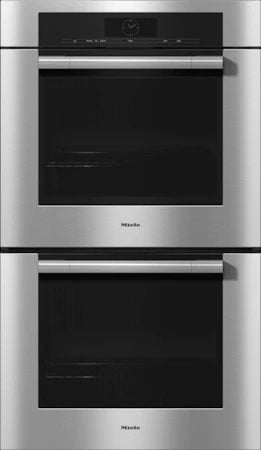Miele vs. Thermador Wall Ovens: Which Should You Buy in 2025?
June 4th, 2025 | 10 min. read

If you're shopping for a luxury wall oven, chances are you've found yourself comparing Miele and Thermador, and it's not an easy choice.
Both are high-quality ovens, but choosing the wrong one can leave you frustrated, especially since they're designed for very different types of cooks.
In this article, we'll simplify the confusion.
You'll clearly see how Miele's precision cooking and advanced steam technology compare with Thermador's versatility and attractive pricing.
This way, you can confidently choose the best oven for your kitchen and cooking style.
📽️ Prefer to watch? In this video, you’ll see Miele’s precision steam and M-Touch compared with Thermador’s speed, side swing doors, and value so you can choose the right wall oven for how you cook.
Quick Comparison: Miele vs. Thermador Wall Ovens (2025)
| Miele | Thermador | |
| Starting Price | $4,899+ | $5,649+ |
| Convection Type | TwinPower True European Convection | Third Element Convection |
| Steam Cooking | Available in the "M-Touch" and "M Touch S Display" Models | Steam and Combi-Steam Ovens Only |
| Smart Features | Miele@home, M-Touch Display | Home Connect App, Masterpiece Controls |
| Cleaning System | Pyrolytic Self-Clean | Self-Clean + EasyClean Options |
| Interface | Full touchscreen (M-Touch) | Digital display with knobs/touch controls |
| Design Options | Modern, flush options | Pro-style with knobs or flush with swing doors |
| Best For | Precision cooking, steam users | Fast cooking, ergonomic installs |
| Warranty | 1-year full, 10 years parts | 2-year full warranty |
Miele Wall Ovens: Precision, Steam, and German Craftsmanship

Miele is the largest family-owned appliance manufacturer in the world, and it shows in how they build their products.
Based in Germany, Miele controls nearly every aspect of production, down to the component level.
While most brands outsource electronics, Miele still makes their own controls.
That means tighter quality control, longer-lasting parts, and a level of engineering you can actually feel when opening the door.
In the wall oven category, Miele stands out for precision cooking and steam innovation.
Their Moisture Plus technology injects bursts of steam at just the right moments, so bread rises higher, meat stays juicier, and your roasted vegetables never dry out.

You can also program how long and when you want steam to be added.
Steam functionality is especially important when roasting in an electric oven, as the drier heat can make your meats less juicy and flavorful.
Every model uses TwinPower True European Convection, featuring dual fans for faster preheating, more consistent temperatures, and better energy efficiency.
And their M-Touch interface is arguably the best in the industry. It’s not just a pretty touchscreen—it’s smart.

You simply select the food type, how you want it cooked, and the oven sets the temperature and time for you.
You can also choose from over 100 automatic recipes, making high-end cooking feel effortless, even if you’re not classically trained.
In a world of complicated appliances, Miele makes cooking feel intuitive and even a little fun.
Another Miele hallmark is the wireless roast probe. It monitors internal temperatures without any cords, so you can cook with precision and without babysitting the oven.
Miele Highlights:
- Steam Cooking: Available in Miele's M series wall ovens
- M-Touch Controls: Sleek, intuitive, and ultra-responsive
- True European Convection: Dual fans, faster preheat, consistent results
- Design: Clean, modern lines with flush, handle-less options
- Build Quality: In-house manufacturing = long-term reliability
- Wireless Probe: Ensures accurate temperature readings and easy use.
Understanding the Differences: Miele Steam & Combi-Steam Ovens

Miele offers two main types of steam-enabled ovens: pure steam ovens and combi-steam ovens (which combine steam with convection).
Within those, you’ll choose between plumbed and non-plumbed (manual reservoir) options. Here's how they differ:
Plumbed Steam Ovens
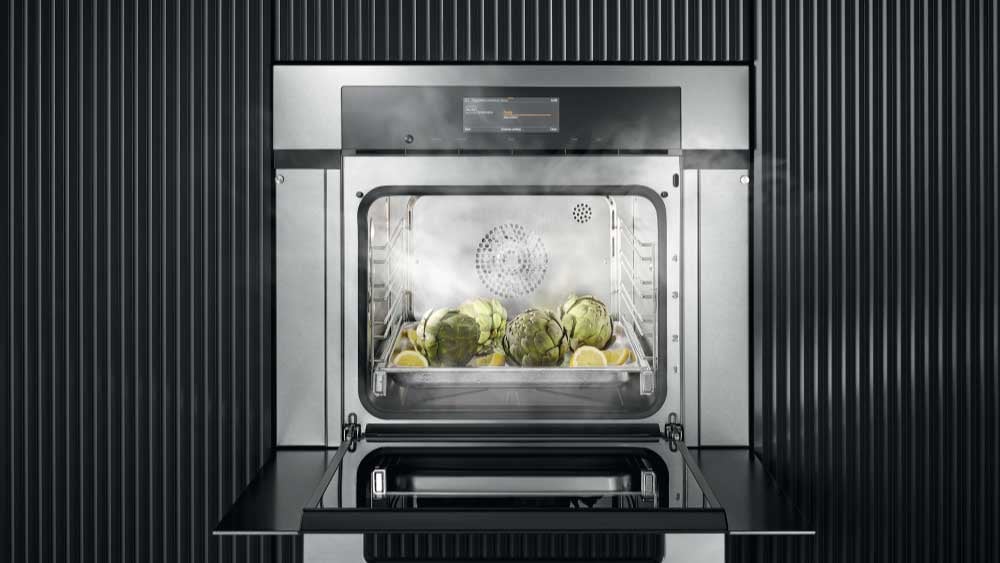
- Hook directly into your water line, so you never have to refill a tank.
- Ideal for new construction or major kitchen remodels where plumbing is accessible.
- More convenient for frequent steam cooking or gourmet users.
- Found in premium models like the Miele DGC 7880.
Best for: Busy cooks who want zero maintenance and consistent steam availability.
Non-Plumbed Steam Ovens (Water Tank)

- Use a concealed refillable water tank—no plumbing required.
- Easier to retrofit into existing kitchens.
- Water tank holds enough for most recipes and is easy to remove and clean.
- Found in models like the Miele DGC 7470.
Best for: Renovations where plumbing isn’t feasible, or occasional steam use.
Steam vs. Combi-Steam: What’s the Difference?
| Best For | Heating Method | |
| Steam Oven | Vegetables, rice, fish, reheating | 100% steam for gentle andmoist cooking |
| Combi-Steam | Roasting, bread, casseroles, baked goods | Combines steam with convection or broil |
Summary:
- If you’re a frequent baker or roast often, go with a combi-steam oven.
- If you love vegetables or want a second oven for healthy cooking, a pure steam model might be enough.
- And if you're building a new kitchen or renovating in Boston, Cape Cod, or Nantucket, go plumbed. If you're retrofitting into an older space, non-plumbed is easier.
Editor’s Note: I have a non-plumbed steam oven. I’ve never run out of water for steam, and I never have to worry about a water line leaking.
Thermador Wall Ovens: Speed, Style, and Smart Flexibility

When I started at Yale, Thermador was a lost brand. They had a cool, niche look, but the reliability was a nightmare.
You’d sell one and hope it didn’t come back. Then Bosch took over.
Bosch, the German engineering powerhouse, acquired Thermador in the late 1990s and transformed it completely.
They didn’t just fix a few parts; they rebuilt the entire product line around performance and reliability.

Thermador wall ovens aren’t as niche or quirky as they once were, but they work. And that’s what matters in a luxury kitchen.
Today, Thermador wall ovens are still built in the U.S., but with German engineering standards baked in.
They offer fast preheat, multiple configurations (including side-swing doors), and design choices ranging from sleek and modern to bold and professional.
While they don’t match Miele’s steam technology or touchscreen interface, Thermador delivers practical performance and strong value, especially with their popular “1-2-Free” rebate program.
Thermador Masterpiece vs. Professional Series
Despite the names, the cooking performance is virtually the same between Thermador’s Masterpiece and Professional wall ovens.
The real differences are in design and a couple of functional tweaks.
Masterpiece is the cleaner, more modern look. It's made to blend into flush cabinetry with slim handles and a sleek digital display.
Professional is bolder. Think big knobs, thicker handles, and a more commercial feel. It’s better if you want your kitchen to look like a chef’s setup.
Functionally, the Professional models offer two main extras.
Thermador has two series of wall ovens: the Select series and the Deluxe series. You can get either series in the Masterpiece look or the Professional look (with dial controls).
The Deluxe series adds a few key features:
- Rotisserie – Only available in the Professional style, not Masterpiece.
- Side-swing doors – Handy if you’re mounting the oven higher on the wall. It gives you easier access.
- Better broiler – More power, more even browning.
- More glide-out racks – Easier to load and unload heavy dishes.
- Multi-Point temperature probe – Measures in three spots for better accuracy.
- Larger broiler pan – More space if you’re cooking for a crowd.
Thermador Steam and Combi-Ovens: Limited, But Unique
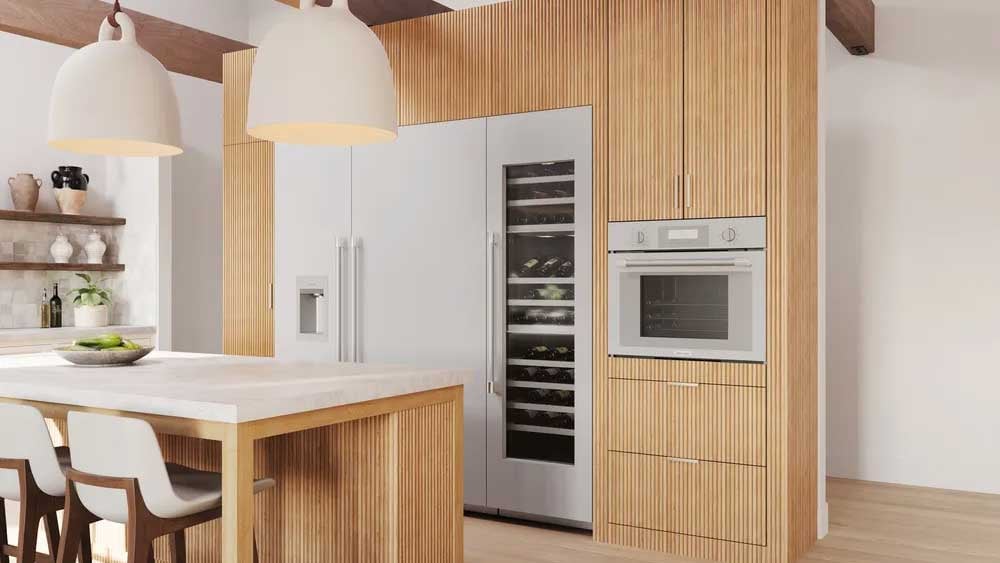
Unlike Miele, steam isn’t Thermador’s core strength, but they do offer it in a few select combi-steam oven models.
Thermador offers their combi-steam ovens in a 30-inch size, while Miele offers both 24-inch and 30-inch options.
Thermador also includes a multi-point temperature probe in their combi-steam oven, which is a nice bonus.

The concept is similar to Miele’s, but Thermador’s execution is more limited. There are no plumbed models, fewer automatic cooking programs, and a simpler interface.
That said, if you’re doing a full Thermador kitchen and want to keep the look consistent, or if you just need a 30-inch steam oven, it’s a solid option.
Thermador Steam & Combi-Steam Ovens: What You Need to Know
Thermador offers a select range of steam and combi-steam ovens, primarily in their Masterpiece and Professional series.
These ovens combine steam and convection cooking, providing versatility for various culinary needs.
Masterpiece Series

Professional Series
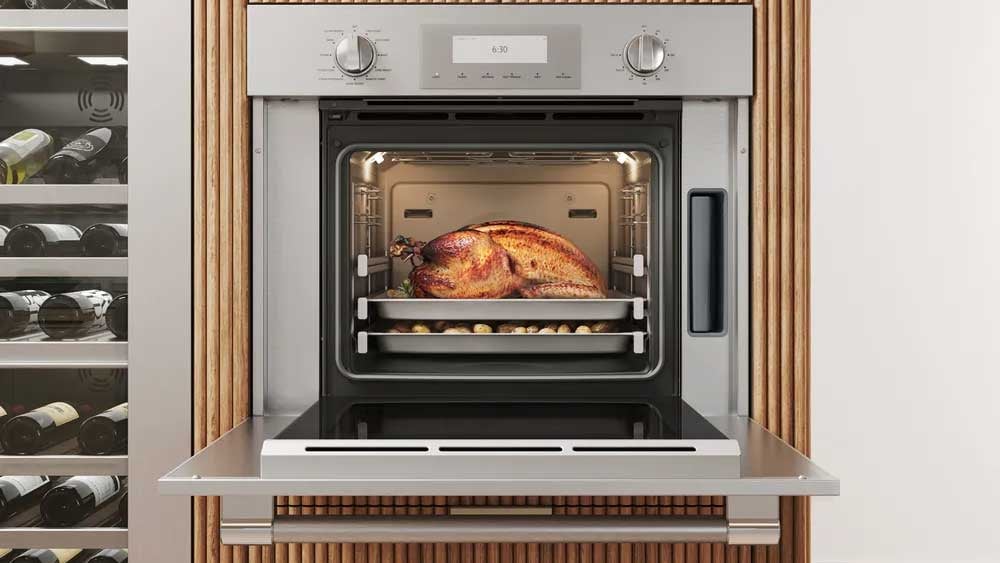
Thermador Key Highlights
- 30" Width: Thermador offers the only 30-inch steam oven on the market, ideal for standard cabinetry.
- Design Integration: Available in both Masterpiece® (sleek, modern) and Professional (bold, commercial) styles.
- Steam & Convection: Combines moist and dry heat for versatile cooking.
- Home Connect: Smart technology for remote control and monitoring.
- Multi-Point probe: Measures temperature in three locations for greater accuracy.
Limitations:
- No Plumbed Models: All models use a manual water reservoir; no direct plumbing option.
- Limited Model Range: Offers fewer options, with no 24-inch size available, unlike competitors such as Miele.
- Simpler Interface: Lacks the advanced touchscreen controls found in some other brands.
Miele vs. Thermador Wall Ovens: Key Differences at a Glance
| Miele | Thermador | |
| Control Interface | M-Touch full-glass touchscreen—intuitive and elegant | Touchscreen + knobs (Masterpiece or Professional styles) |
| Convection System | TwinPower True European Convection (dual fan) | Third-element convection (single fan) |
| Steam Cooking | Steam and combi-steam available in most models | Limited to combi-steam ovens with 30" width |
| Smart Features | Miele@home + auto programs (100+ recipes) | Home Connect app + voice integration |
| Side-Swing Door | ❌ Not available | ✅ Available in Professional Series |
| Rotisserie | ❌ Not available | ✅ Available in Masterpiece or Professional styles, including Deluxe series models with side-swing doors. |
| Design Fit | Handle-less and flush install options | Side-Swing Door Options |
| Starting Price (Single) | 4,899+ | 5,649+ |
| Reliability/Build | Built in Germany—controls manufactured in-house | Built in U.S.—owned by Bosch, German-engineered |
| Warranty | 1-year full, 10-year on select parts | 2-year full warranty |
Which Wall Oven Is Right for You?
This really comes down to how you cook and how much you value certain features over convenience or price.
Choose Thermador if...
You want a high-performing oven that’s fast, flexible, and easier on the wallet.
Thermador wall ovens heat up quickly, handle everyday cooking well, and offer more design options, especially if you're building out a full Thermador kitchen.
One of Thermador’s biggest advantages is the side-swing door, available in the Deluxe Series.

If you’re mounting the oven high, such as above a warming drawer or a combi-steam oven, the side-swing door is safer and more comfortable than reaching over a hot drop-down door with a heavy pan.
Keep in mind, Thermador only offers 30-inch steam ovens. That can be a drawback if you have a smaller space and need a 24-inch option.
The steam system is more basic, with no plumbed models and fewer automatic cooking features compared to Miele.

Add in the 1-2-Free rebate, and Thermador becomes a smart value play.
It’s a great choice for busy families or second homes where speed and simplicity matter more than gourmet-level precision.
Choose Miele if...
You value precision, consistency, and thoughtful design. Miele’s M-Touch interface is the best we’ve used.
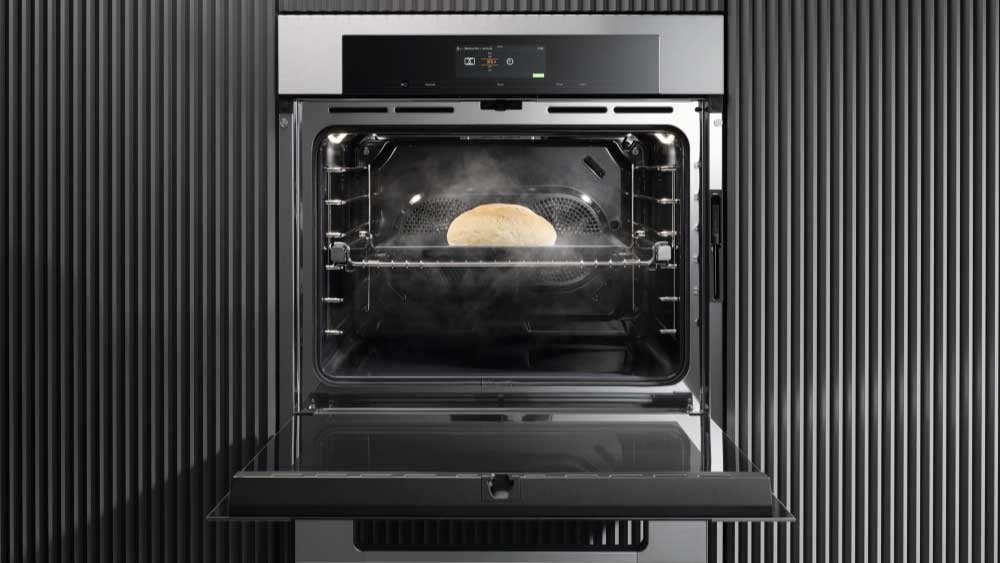
Tap the food type, choose how you want it cooked, and the oven takes it from there. No guessing and no fiddling with settings.
If you bake, roast, or reheat often, the Moisture Plus steam assist gives you a real edge.
It helps retain moisture in meats and baked goods, which is especially important in electric ovens that tend to run dry.
Miele’s TwinPower convection fans deliver even, stable heat, and the ovens are whisper-quiet. It's built for people who cook often and care about results.

It’s more expensive, yes, but it’s built to last, and you’ll feel the difference every time you use it.
Miele vs. Thermador Wall Ovens: Pros & Cons
| Pros | Cons | |
| Miele | - Best-in-class touchscreen (M-Touch)
- Steam assist available in most models - Twin convection fans for even heat - Exceptionally quiet and precise - Built in Germany with in-house component manufacturing |
- Higher upfront cost
- No side-swing door options - Fewer promotions or rebates |
| Thermador | - Lower starting price
- Side-swing door options (more ergonomic) - Fast preheat and solid convection performance - Only brand with a 30" steam oven - “1-2-Free” rebate program for kitchen packages |
- Steam models are limited and not plumbed
- Controls are less refined than Miele’s - Fewer automatic cooking programs |
Final Take

If you care about cooking precision, ease of use, and long-term quality, Miele is the stronger choice.
It’s designed for people who cook often and expect consistent, high-end results without the guesswork.
The steam assist, intuitive controls, and dual convection fans give you more control over how your food turns out, especially if you’re baking, roasting, or reheating.
If you’re looking for solid performance, more flexibility, and better value, Thermador is a smart option.
It heats quickly, offers practical upgrades like side-swing doors, and includes the only 30-inch steam oven on the market, which is ideal for standard cabinet layouts.
Add in the rebate program, and you get more kitchen for the money.
Best Miele and Thermador Wall Ovens to Consider in 2025
Miele Wall Ovens
Miele H 7880 BP – Flagship Single Wall Oven
Touchscreen, steam assist, wireless probe, built-in camera, and twin convection. This model includes everything Miele does best in one oven.
Best for: Serious cooks who want precision and convenience without compromise.
Miele H 7780 BP2 CTS – Double Wall Oven with Steam Assist
Full-size double oven with Moisture Plus in both cavities. Features the M-Touch interface, quiet operation, and durable build.
Best for: Large households or entertainers who cook multiple dishes at once.
Miele DGC 7470 – Combi-Steam Oven (Non-Plumbed)
Combines steam and convection in a compact format. An ideal second oven or a complement to a full-size model.
Best for: Healthier cooking, reheating, and baking without plumbing requirements.
Thermador Wall Ovens
Thermador PODS301B – 30" Professional Series Single Oven
Large capacity, fast preheat, commercial-style dial controls, and a built-in rotisserie. Includes smart features and deluxe performance.
Best for: Someone looking for a commercial kitchen look with everyday ease of use.
Thermador MEDS301BS – 30" Masterpiece Series Steam and Convection Oven
Sleek Masterpiece styling with deluxe features like a rotisserie, additional glide racks, and a multi-point temperature probe. Uses a manual water reservoir.
Best for: Kitchens with 30-inch cabinetry that need steam flexibility without a full redesign.
Thermador PODS302B – Double Wall Oven, Professional Style
Double oven with combi-steam on top and standard convection below. Large capacity, fast preheat, smart-enabled, and rebate eligible.
Best for: Busy families or home chefs who want both size and speed.
🔍Read More: The Best Wall Ovens
FAQs
Answers to the most commonly asked questions about Miele and Thermador wall ovens.
Are Miele wall ovens worth the premium price?
Yes—if you cook often and care about results. Miele ovens offer superior controls, dual convection fans, and steam assist in most models. They're also quieter and built to last. If you’re someone who roasts, bakes, or reheats regularly, you’ll notice the difference—especially over time.
Is Thermador considered a luxury brand like Miele?
Thermador is a premium brand, but not quite in the same category as Miele when it comes to engineering or control technology. That said, it’s well-built, made in the U.S., and backed by Bosch’s engineering standards. It also offers more options at a lower price—and some real conveniences like side-swing doors and faster preheat.
Which wall oven brand is more reliable?
Both brands are reliable, but they’re different. Miele manufactures more of their own parts, including electronics, which helps with long-term durability. Thermador, owned by Bosch, has dramatically improved since the ‘90s and now builds solid ovens in the U.S. with better service coverage and a 2-year full warranty.
Can I install a Miele or Thermador wall oven myself?
Not recommended. These ovens require electrical connections and precise cabinetry measurements, especially if you're installing a steam model or going for a flush fit. For homeowners in Greater Boston, MetroWest, the South Shore, or Cape Cod, Yale offers professional installation—and we actually service what we sell.
What’s the difference between a steam oven and a convection oven?
A convection oven uses a fan to circulate dry heat—great for even baking and roasting. A steam oven adds moisture during cooking, which helps keep food juicy and flavorful. Combi-steam ovens (offered by both brands) give you the best of both worlds: moisture and browning.
Still Deciding Between Miele and Thermador?
Join over 1 million homeowners who’ve downloaded our appliance buying guides. Our Wall Oven Buying Guide includes:
✔️ Side-by-side brand comparisons
✔️ Real reliability stats from our service team
✔️ Expert advice based on decades of showroom experience
We’ve taken the guesswork out of buying. Now it’s your move.
📍 Or better yet—visit one of our 6 showrooms in Boston, Framingham, Hanover, Norton, Hyannis, or Nantucket and try the ovens for yourself.
👉 Get the Free Wall Oven Buying Guide
Related Articles
Why Should You Trust Us?
It seems that every appliance review has nothing but glowing comments about almost every product, yet you read customer reviews and they are almost universally bad.
We are here to fill in the disconnect. We'll give you the best features, and the drawbacks as well, including reliability based on over 37,000 calls performed by our service team just last year. Our goal is to give you ALL the information so you know what's right for you.
Please consider subscribing or adding to the conversation in the comments below. We appreciate you stopping by.
Steve Sheinkopf is the third-generation CEO of Yale Appliance and a lifelong Bostonian. He has over 38 years of experience in the appliance industry, and he is a trusted source of information for consumers on how to buy and repair appliances.
Steve has also been featured in numerous publications, including the
New York Times,
Consumer Reports,
The Boston Globe,
Bloomberg Radio, the
New York Post,
The Wall Street Journal, and
Entrepreneur, for his knowledge of how to buy appliances and appliance repair.
Steve is passionate about helping consumers find the best appliances for their needs, and he is always happy to answer questions and provide advice. He is a valuable resource for consumers who are looking for information on appliance buying, repair, and maintenance.
Despite being the worst goalie in history, Steve is a fan of the Bruins and college hockey, loves to read, and is a Peloton biker. The love of his life is his daughter, Sophie.
A Note About Pricing
Pricing on this blog is for reference only and may include time sensitive rebates. We make every attempt to provide accurate pricing at time of publishing. Please call the stores for most accurate price.
Topics:



